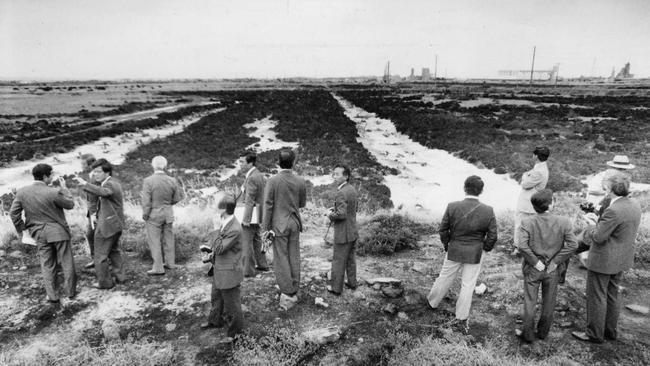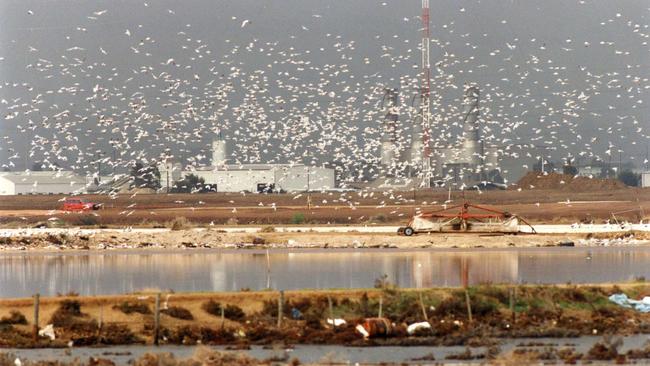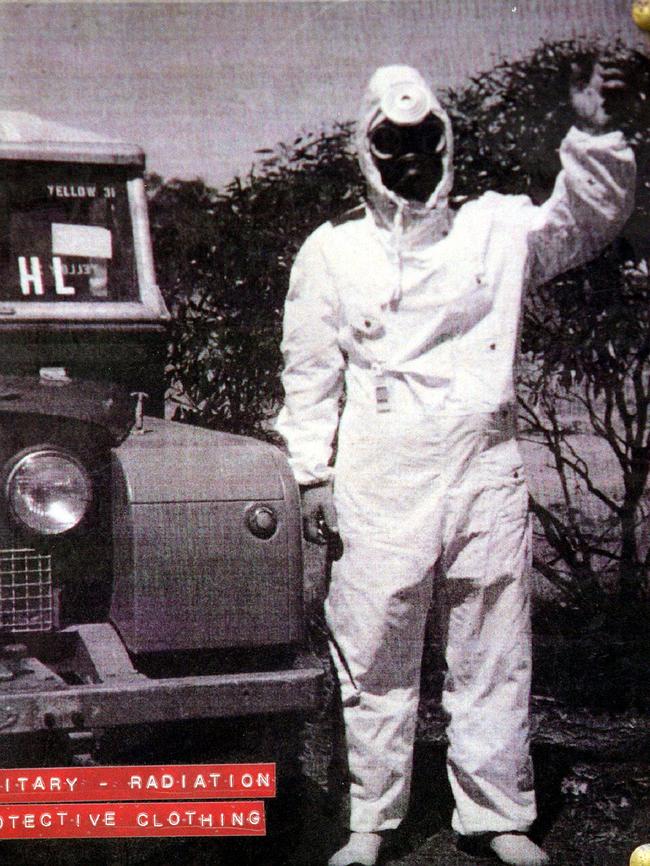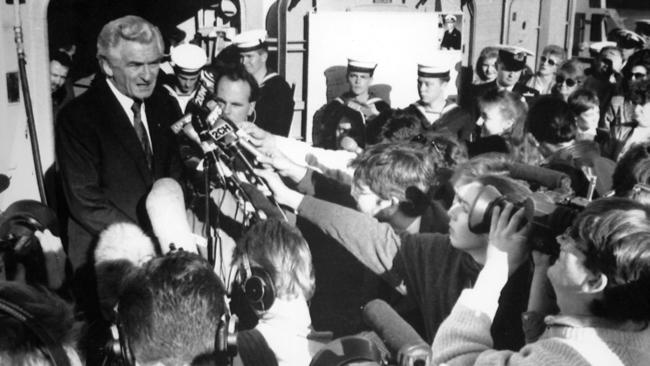Cabinet papers reveal public servants warned against spending money on doomed Multi Function Polis in 1990
THE Australian Government wanted Britain to contribute almost $70 million towards the clean-up of the Maralinga and Emu nuclear test sites but ended up being forced to settle for just $45 million in 1993.

SA News
Don't miss out on the headlines from SA News. Followed categories will be added to My News.
FEDERAL Government bean counters advised cabinet in 1990 against providing further financial support to the doomed Multi Function Polis, documents released by the National Archives of Australia show.
The Australian and Japanese governments wanted the hi-tech city planned for Gillman
near Mawson Lakes to house new industries and a “world university” to help diversify the Australian economy away from over-reliance on commodities.
Australian taxpayers spent about $150 million on the project before it was formally abandoned in the late 1990s.
Cabinet decided in August 1990 to contribute $4 million towards viability studies on MFP-Adelaide.
But the project was already facing public opposition and criticism from the Commonwealth Finance Department.

Advice from the department said the real test of the MFP would be whether it could attract private sector investors without Commonwealth support or guarantees.
“Finance considers that recent history more than demonstrates that governments should not sponsor or be stakeholders in major new capital ventures,’’ the advice said.
“Their presence, by telegraphing support (if not implicit guarantees) or such ventures, raises expectations and can result in an overoptimistic bias in an feasibility assessment.’’
South Australian Premier John Bannon, who died last month, succeeded in fighting off competing bids from NSW, Queensland and Victoria to host the MFP, which was derided by some critics as “Jap City’’.
Industry Minister John Button had publicly stated that the project would not proceed past the study stage unless there was broad community support.
He briefed cabinet that much media and other comment about the MFP was based on the incorrect perceptions that it would be: “an enclave, dominated by a foreign population and overseas investment interests while only providing menial jobs for Australians.’’

“….it is essential that the MFP be subject to robust public debate to help realise its value as an instrument of change in the Australian economy and society generally,’’ Senator Button wrote.
Although the MFP project was formally scrapped in 1997, it helped prompt the development of the Mawson Lakes residential, commercial and university development.
The MFP would have had about 100,000 residents living in a series of interconnected villages.
Plans drafted by an international steering committee envisaged an internet-type communications system.
“The communications system will be a multimedia knowledge network, with computer moderated digital communications carrying voice, data and images between villages the metropolis and the world,’’ a briefing document provided to cabinet said.
Federal concern over State Bank failure
GOVERNMENT revenue to fund hospitals, schools and roads in South Australia plummeted in the wake of the 1991 State Bank collapse.
The 1990 and 1991 federal Cabinet papers span the period when the Australian economy became mired in the “recession we had to have’’ and the State Bank failed, exposing taxpayers to a $3.1 billion liability. After home-loan interest rates hit 18.5 per cent in 1989, Australia found itself with a 10.8 per cent unemployment rate by late 1991.
A confidential federal Cabinet submission from then-treasurer Paul Keating in May 1991 warned that SA state government revenue was falling in the wake of the bank collapse in February and the situation was likely to worsen.
“Further fiscal deterioration (in SA) is a prospect for 1991-92,” Mr Keating told Cabinet.
The state received an additional $154.5 million in federal grants in 1991-92 and ultimately benefited from a $600 million federal assistance package.
“We underestimated the resilience (of the market economy),’’ former prime minister Bob Hawke said, ahead of the release of the papers. “We should have started improving interest rates up earlier than when we did.”
Purchase of extra subs was deferred
THE HAWKE Cabinet ruled out ordering the $1 billion construction of two extra Collins Class submarines in Adelaide partly in order to maintain “leverage” over the builder.
As the Turnbull Government prepares to reveal how many Future Submarines it will order, Cabinet papers from 1990 released today provide an insight into the decisions made by the Hawke Government about construction of the six Collins Class boats.
Cabinet agreed in October 1990 to defer for several years a decision on whether to purchase more submarines in addition to the six ordered to replace the Oberon Class boats.
Then-defence minister Robert Ray told Cabinet construction of two more submarines would cost an estimated $1.01 billion and deferring a decision would give the Government more “leverage’’ over what was then known as the Australian Submarine Corporation.
“By deferring a decision instead, the Commonwealth retains significant leverage over the prime contractor,’’ Senator Ray said. “ASC is still in an early stage of building the first Collins Class.’’
The $4.3 billion contract between the Federal Government and the ASC contained provision for two extra submarines to be ordered.
The six Collins Class submarines were ordered in June 1987, with the first going into service in 1996.
The Liberal Party promised before the 2013 election to build 12 Future Submarines at the ASC. However, the Defence White Paper due to be released early this year is expected to reveal the Government will order a smaller number of submarines.
The ASC has previously estimated the cost-per-boat would fall significantly thanks to efficiencies if the Government orders 12 submarines instead of six.
German shipbuilder TKMS, France’s DCNS and the Japanese Government have all lodged bids to build the new submarines.
Australia demanded $70m for Maralinga
THE Australian Government wanted Britain to contribute almost $70 million towards the clean-up of the Maralinga and Emu nuclear test sites but ended up being forced to settle for just $45 million in 1993.
Cabinet documents from 1990 and 1991 show Bob Hawke’s Government was determined to ensure the UK Government made a substantial financial contribution to the rehabilitation of its former nuclear test sites in Australia.


In August 1991, Cabinet agreed that Mr Hawke should write to British Prime Minister John Major seeking the contribution. Then-primary industries minister Simon Crean advised Cabinet the British should be asked to contribute $69.9 million to the estimated $93 million clean-up cost.
Mr Crean wrote in a Cabinet submission that the British Government had refused to accept responsibility for compensating Aboriginal people affected by the tests conducted between 1953 and 1963. Legal advice indicated the Maralinga Tjarutja people had no case against the Britain for compensation under international law.
“Insistence on payment by the UK of Aboriginal compensation would seriously detract from Australia’s efforts to seek rehabilitation funds from the British,’’ Mr Crean wrote.
The clean up ended up costing $108 million.
Hundreds of sailors at risk from missile attack
HUNDREDS of sailors would be killed if Iraqi forces successfully launched missiles against Australian Navy ships sent to the Persian Gulf, the Hawke Cabinet was warned.
Australia committed two guided missile frigates and a replenishment tanker to a multinational naval force after Iraq invaded Kuwait in 1990.
Cabinet documents show the Government considered the 860 sailors on the three vessels were being sent to a “high-risk environment’’.
In a Cabinet submission, then defence minister Robert Ray said there was a chance the ships could be attacked with conventional or chemical weapons.
“It should be noted the threat of attack from Iraqi air and surface launched anti-ship capable missiles will make this a high-risk operation, where a hit sustained by an Australian warship could result not only in the loss of that ship, but also in a high number of personnel casualties,’’ Senator Ray said.

Mr Hawke has recalled warning US President George H. Bush against ordering US forces to push on to Baghdad after Kuwait was liberated in February 1991.
He recalled telling Mr Bush there was “no way’’ US forces should occupy Baghdad to topple Saddam Hussein’s regime as it would be breaking a trust to change the mandate unilaterally. The President agreed.
“Unfortunately, his son didn’t inherit his good sense in these matters,’’ he said.
Early in the Gulf crisis, Mr Bush Sr told Mr Hawke Canadian Prime Minister Brian Mulroney was reluctant to join the international coalition because Iraq was a big wheat export market for Canada. Mr Hawke told Mr Bush to “leave Mulroney to me”.
“We were good mates,” he said. “I said, ‘Hey Brian, what’s this crap I hear from George about, you know, not coming aboard in regard to getting Saddam out of (Kuwait) because of your wheat trade?’
“I said, ‘We’ve got a bloody big wheat trade too but we’re in.’ He said, ‘OK Bob, we’re in too’.’’
Major events in 1990 and 1991
1990
Jan 24 Victorian Football League becomes the Australian Football League
Feb 12 Carmen Lawrence becomes Premier of Western Australia, Australia’s first female premier
Mar 25 Bob Hawke’s Labor Government wins a record fourth term
July 19 Kerry Packer buys back Channel 9 from Alan Bond
Oct 2 Opera singer Dame Joan Sutherland, right, announces her retirement
Oct 8 Collingwood wins first football premiership since 1958, defeating Essendon
Nov 12 Prime Minister Bob Hawke announces that the risk of war in the Persian Gulf had increased as two more Australian guided missile vessels leave for the Gulf
Nov 29 Treasurer Paul Keating announces that Australia is experiencing a recession
No. 1 single:Nothing Compares 2 U — Sinéad O’Connor
1991
Jan 1 The University of South Australia is formed through the amalgamation of the South Australian Institute of Technology and the South Australian College of Advanced Education
Jan 17 Gulf War begins, with PM Hawke giving battle orders to the navy in the Gulf after a telephone call from US President George Bush
Jan 19 Peace marches across Australia demand withdrawal of Australian forces from the Gulf
Feb10 SA Premier John Bannon reveals a $970 million bailout of the State Bank to cover expected losses. He announces a royal commission. Managing director Tim Marcus Clark resigns.
Mar 22 The Adelaide Crows play their first game in the AFL
Jun 3 Paul Keating makes his first challenge against Bob Hawke for ALP leadership. Hawke wins 66-44, and Keating resigns as Treasurer
July 4 Pioneering heart surgeon Victor Chang, right, gunned down in a street in Mosman, Sydney
July 10 Adelaide Entertainment Centre is officially opened
Oct 19 Perjury trial of former Queensland premier Sir Joh Bjelke-Petersen ends in a hung jury. Prosecutors decide against a retrial on the basis of his advancing age
Dec 19 Paul Keating makes his second Labor leadership challenge, this time winning 56-51 to become Australia’s 24th Prime Minister
No. 1 single:Everything I Do
(I Do It For You) —
Bryan Adams


